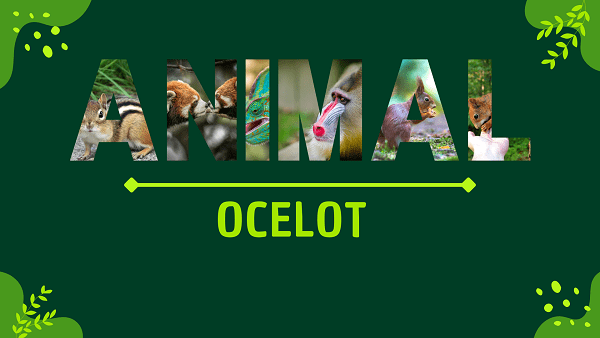Ocelot | Facts, Diet, Habitat & Pictures
Home » Animals » Ocelot | Facts, Diet, Habitat & Pictures
Ocelot Overview
Appearance
The ocelot is a medium-sized wild cat with a striking appearance. It has a sleek and slender body covered in a tawny, golden-yellow coat adorned with distinctive dark rosette patterns. These rosettes consist of elongated, irregularly shaped spots with a dark border.
Its short tail is also marked with bands and a black tip. Ocelots have expressive, large round eyes with vertical slits and a white underside that contrasts sharply with their coat. This elegant cat’s appearance helps it blend into its forested habitat.
Origins And Evolution
The ocelot’s origins and evolution can be traced back to the early ancestors of modern cats that inhabited the ancient forests. Over millions of years, these ancestors gradually adapted to their environments. Ocelots belong to the family Felidae, showcasing their evolutionary kinship with other wild cats.
Fossils of ocelot-like creatures have been found dating back to the Pleistocene epoch, around 2.5 million years ago. Their evolutionary journey led to the development of a compact, agile body, camouflaging rosette patterns, and acute nocturnal vision, making them skilled hunters in dense forests.
Ocelots have successfully survived and thrived through natural selection, adapting to various habitats across the Americas and earning their place as a distinct and iconic feline species.
Behavior and Lifestyle
The ocelot’s origins and evolution can be traced back to the early ancestors of modern cats that inhabited the ancient forests. Over millions of years, these ancestors gradually adapted to their environments. Ocelots belong to the family Felidae, showcasing their evolutionary kinship with other wild cats.
Fossils of ocelot-like creatures have been found dating back to the Pleistocene epoch, around 2.5 million years ago. Their evolutionary journey led to the development of a compact, agile body, camouflaging rosette patterns, and acute nocturnal vision, making them skilled hunters in dense forests.
Scientific Classification
- Kingdom: Animalia
- Phylum: Chordata
- Class: Mammalia
- Order: Carnivora
- Family: Felidae
- Genus: Leopardus
- Species: Leopardus pardalis
Locations
- North America
- Central America
- South America
- Mexico
- Brazil
- Colombia
- Peru
- Venezuela
- Ecuador
- Bolivia
Fast Facts
- Name: Ocelot
- Scientific Name: Leopardus pardalis
- Habitat: Forests, Grasslands
- Diet: Carnivorous, Varied
- Physical Features: Spotted Coat
- Nocturnal: Mostly Night
- Solitary: Independent Hunter
- Unique Order: Carnivora Family
- Lifespan: 10-15 years
- Conservation Status: Least Concern
- Fun Facts: Excellent Swimmer, Agile Climber
Physical Characteristics
- Color: Spotted Coat
- Skin Type: Short Fur
- Top Speed: 40 mph
- Lifespan: 10-15 years
- Weight: 20-40 lbs
- Length: 2-3 ft
- Age of Sexual Maturity: 2 years
- Age of Weaning: 2 months
FAQs
What is an ocelot?
An ocelot is a medium-sized wild cat known for its striking appearance, including a golden-yellow coat with dark rosette patterns.
Where are ocelots found in the wild?
Ocelots are found in various habitats across North and South America, including rainforests, grasslands, and savannas.
What do ocelots eat?
Ocelots are carnivorous hunters, primarily feeding on small mammals, birds, reptiles, and occasionally fish.
Are ocelots good climbers?
Yes, ocelots are excellent climbers and can navigate trees and other elevated terrain with ease.
Are ocelots endangered?
While ocelots face threats such as habitat loss and poaching, they are generally listed as “Least Concern” by the International Union for Conservation of Nature (IUCN) due to their relatively stable population.


